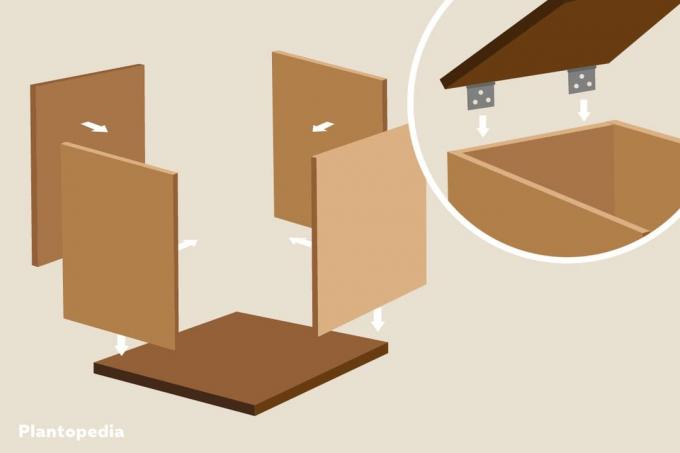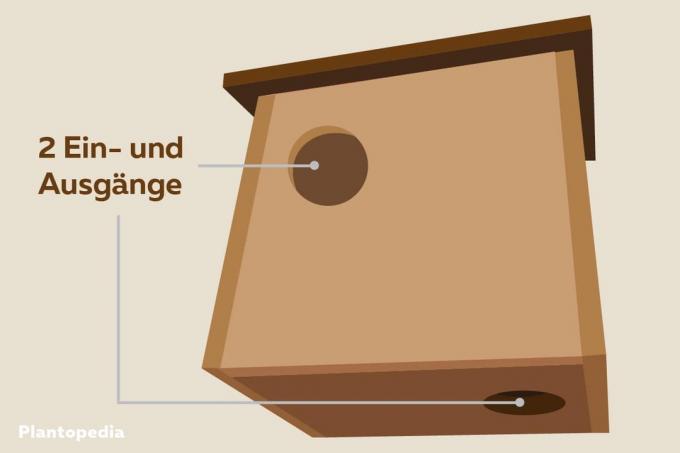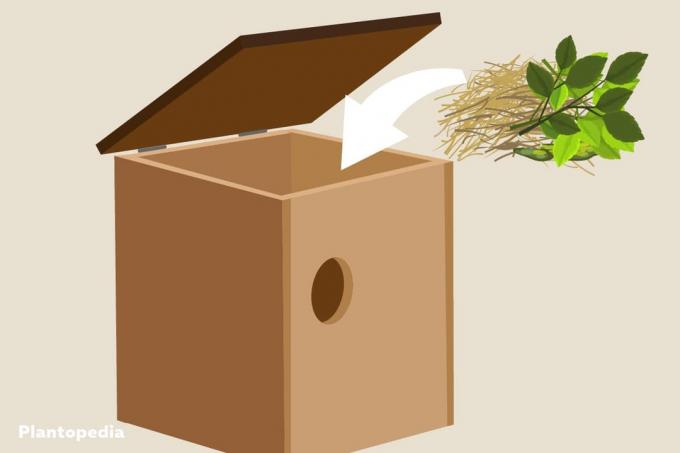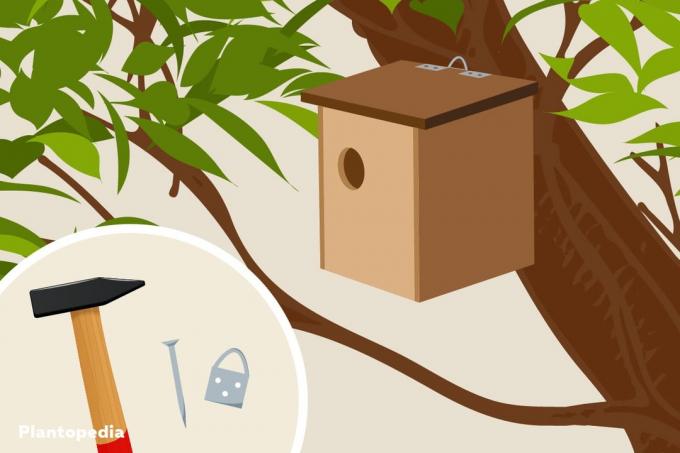
table of contents
- Background - the importance of the Kobel
- Basics of construction
- Build a squirrel nest
- Nests in the forest
- Nests in the garden
- frequently asked Questions
If you want to watch squirrels romp in your own garden, you have to create an environment in which they feel comfortable. Squirrel nests are definitely one of them. Fortunately, it doesn't take a great deal of skill to build such a squirrel nest.
In a nutshell
- are also called Kobel
- each animal has several pobles with different tasks
- Orientation on the basic shape of a bird feeder
- comfortable interior that is attractive to squirrels
- Place the Kobel as high up in a tree as possible so that it offers protection
Background - the importance of the Kobel
In spring and especially in summer it is a real pleasure to watch squirrels in your own garden. In order for this to work, however, the garden must be as attractive and appealing to the tree acrobats as possible. This not only means that enough tasty food should be available, but also a certain number of squirrel nests, the so-called Kobeln. Every animal in nature has several of these goblins. They mainly serve as
- Litter and lift location for the boys
- Resting place where adult animals sleep
- Refuge and retreat that offer protection from predators
- Storage for nuts and other feed

It is important that no Kobel fulfills all of these tasks at the same time. A squirrel, for example, would never set up its food store in the Kobel in which it also sleeps or in which it raises its offspring. Squirrel nests are extremely important for animals and are essential if they are to feel comfortable in a certain environment.
Basics of construction
The basis for our squirrel nest in our own garden is the principle of a bird feeder. Unlike outside in the forest, our Kobel will not have the shape of a sphere, but rather that of a rectangle or square. We mainly use wood as a material. The wood for the walls should have a thickness of at least two centimeters and, if possible, be a soft wood such as beech, maple or pine. Only untreated wood should be used. A glaze to protect against moisture is recommended, but it must be organic.

Build a squirrel nest
Step 1: determine the dimensions
The footprint of our squirrel house should be at least 26 x 26 centimeters. However, it is better not to save space. The base plate is then cut to size according to the base area that has been chosen. The four side parts should not be less than 30 centimeters in height. It is advisable to bevel the walls for the left and right sides and cut the front by two centimeters. In this way it is possible to mount the roof at an angle so that the rainwater can drain away. The roof panel should be larger than the base area and, in particular, extend a good two centimeters beyond the side walls.
Step 2: build a house
Once the individual pieces of wood have been cut to the right size, you can start building the actual house out of them. To do this, the four side parts are first attached to the sides of the base plate. Ideally, small nails or fine screws are used for this.
The roof is best attached to the back with two small hinges so that you can open it at any time to get into the interior. In this case, however, a secure lock is necessary so that other animals cannot get into the Kobel via the roof. A simple hook fastener is usually sufficient for this.

Note: Wood glue is less suitable because it can contain chemical ingredients that could harm the squirrel.
Step 3: cut entry holes
Each Kobel should have at least two single or Have outputs. These are usually circular holes that are cut into the wood. The diameter should be seven to eight centimeters each. One of these holes is ideally placed in the base plate near the trunk so that the croissant can quickly escape from the cob in case of danger.

Step 4: Dress up and glaze the house
In order to camouflage the house as well as possible, it would be wise to cover it with pieces of bark or moss, for example. These can simply be glued to the outside. Before that, however, the house should be given a bio-based glaze to protect it from moisture.
Step 5: interior decoration
In order for the squirrels to really feel comfortable in their Kobel, it should be as comfortable and cozy as possible in the interior. Are suitable for this
- Mosses
- weave
- leaves
- straw
- hay

Fill the interior from above via the open roof. If you use a mixture of hay and straw, after filling, a hollow is made with the hand clenched in a fist, in which the animals can cuddle up.
Step 6: placement
Since there are usually fruit trees in the garden, it makes sense to place one or more goblins in their treetops if possible. To do this, select a stable side branch. Attach the Kobel to this branch in close proximity to the trunk. Either nail it on or tie it to the trunk with a sturdy cable tie. It is important that you only place one squirrel nest per tree.

Nests in the forest
In the wild, squirrels make amazingly stable and long-lasting goblins. The animals usually make them from branches and pieces of bark that they find in the forest and bring them into a spherical shape. The croissants use moss and leaves for the interior decoration of the Kobel. However, the placement is even more important to them than the shape or the equipment. A Kobel is usually erected in the forest in the treetops with a height of at least four meters. This amount is intended to provide a minimum level of protection Predators guarantee:
- marten
- Weasel
- foxes
- Domestic cats

A Kobel in the great outdoors always has two one or two Outputs. The second exit is usually at the bottom and is placed as close as possible to the tree trunk. The squirrel has the opportunity to be quickly brought to safety in the event of an impending danger. Each croissant has several goblets. They are used differently in each case. This includes
- Birth and rearing of young animals
- Sleeping places
- Food hiding places
- Retreats in case of danger
Nests in the garden
Nests in your own garden are usually only built to house squirrels. They should therefore meet the demands that animals place on them in the forest. For the sake of simplicity, however, the spherical shape is not used in the construction, but is based on the principle of a bird feeder. However, it is of great importance that the house is placed as high and securely as possible in a treetop. In any case, it makes sense not to just build a single nest and offer it to the animals, but always several nests at the same time. The animals have a free choice. The goblins in the garden usually become
- placed high up in the canopy of fruit trees
- attached to a stable, larger side branch
- Attached as far as possible from places where people often stay

If possible, you should distribute the various Kobeln over the entire property and not place them in one place.
frequently asked Questions
That can only be decided by the animal and cannot be predicted. It is clear, however, that the goblin appears to the croissant as attractive and the chances of it taking possession of it increase certainly increase.
Unfortunately, this question cannot be answered unequivocally either. It is important that the animals can choose. So it should definitely be more than just a single nest. An offer of at least three different nests in the garden is usually ideal.
This usually works best with food. Untreated nuts, which must not be salted, are ideal for this. But certain grains and seeds are also a treat for the croissants. You can also offer certain fruits such as apricots. You should keep your hands off lemons and oranges, however. They are usually too angry with the animals.



